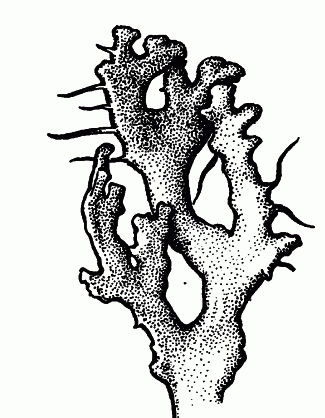Phaeophyscia constipata (Norrlin & Nyl.) Moberg
Upstanding shadow
Physciaceae
Introduction to the Lichens
Upstanding shadow
Physciaceae
Introduction to the Lichens
Map
Distribution of Phaeophyscia constipata unavailable
Species Information
General:
Common Name: The Shadow Lichens. Alludes to the dark colour of the upper surface of most species. Small to medium stratified foliose lichens, corticate above and below, isidiate or sorediate or not, lobes closely appressed to semi-erect, elongate-linear to elongate (rarely short), averaging to 0.2–1.5 (–3) mm wide, thin. Upper surface usually brownish, K- (atranorin absent), dull, lacking pruina and white-spotting. Lower surface dark brown to black, occasionally pale, bearing scattered, short, simple rhizines. Medulla white (ours). Photobiont green.
Apothecia located over upper surface, averaging to 1–2.5 mm across, rim occasionally bearing short colourless hairs, disc dark; spores 2-celled, ellipsoid to spindle-shaped, brown, 8 per ascus.
Over rock, bark, moss and other substrates.
Notes: Of the 19 species of Phaeophyscia reported for North America, ten are known to occur in B.C. Phaeophyscia was formerly treated within Physcia.
Species description:
Lobes averaging to less than 1.5 mm wide; upper surface convex to rarely concave at lobe tips; rhizines projecting or not; distribution and status various AND
Thallus lacking soredia and isidia; apothecia present or absent AND
Lobes mostly semi-erect; lower surface pale; apothecia rare
Reactions:
All spot tests negative, except lower medulla rarely K+ violet.
Contents:
No lichen substances reported, except an unidentified anthraquinone rarely present.
Source: Lichens of British Columbia
Illustration

If more than one illustration is available for a species (e.g., separate illustrations were provided for two subspecies) then links to the separate images will be provided below. Note that individual subspecies or varietal illustrations are not always available.
Illustration By: Trevor Goward
Habitat and Range
Habitat: Frequent over base-rich moss and mossy rock in open to somewhat sheltered intermontane sites, usually at lower elevationsWorld Distribution: N Am – western Eurasia, N to AK, S to CO.
Source: Lichens of British Columbia
Status Information
Synonyms
Synonyms and Alternate Names:
Physcia constipata Norrlin & Nyl.